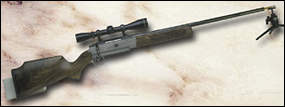
This lightweight metal has found its way
into a surprising number of firearms applications -
and now it's responsible for a new class
of very accurate hunting rifles.
By W.T. Woodard
You may remember when hunters achieved "accuracy" in their rifles by meticulously mating wood, fiberglass, and steel with the right lead, copper and brass. But now the metal you wrap your venison in is increasingly responsible for putting the meat there in the first place.
Aluminum has become a prime component of many of the most accurate rifles being sold today, ranging from high-end benchrest-quality rifles to aftermarket gunsmithing jobs. The reasons: Light weight, low cost, corrosion resistance and ease of machining. More important, of course, is that it greatly aids accuracy when employed as a foundation for the action in the stock.
Aluminum has a long history in gun making, often being described as the "alloy" in lightweight handgun frames and being used in weight-shaving components like trigger guards, floorplates and scope rings. But it wasn't until benchrest shooters began incorporating the metal into the stocks and frames of their super-accurate 6mm PPCs that the metal found its next calling.
What Benchresters Learned For Us
The competition benchrest innovators found that aluminum, when incorporated into gunstocks, vastly increased the rigidity of the stock/action/barrel unit, and this rigidity translated into consistency, which in thighbone-connected-to-the-hipbone fashion, promoted accuracy. Also, because some of the benchrest classes have weight restrictions, those shooters could employ aluminum, get the accuracy they craved and still make weight in some of the lighter gun classes.
 And it is this weight-to-strength factor that has ultimately led to aluminum showing up in field guns. And it is this weight-to-strength factor that has ultimately led to aluminum showing up in field guns.
The Heart of the Trans Pecos
This trend can be seen in a number of guns, but none more prominently than in the Trans Pecos, a new gun built by renowned shotgun choke-tube maker Briley Manufacturing Inc., of Houston. General Manager Chuck Webb and rifle gunsmith Bobby Pitchford are both accuracy nuts, and their experience lead them to incorporate aluminum as a prime component of the company's new $3,000 rifles.
Pitchford's expertise is making inaccurate guns shoot better. He has bled in rivers of fiberglass and removed mountains of wood shavings trying to make production-gun groups shrink to as near as MOA as he can get them. Accordingly, he's a big fan of pillar bedding and aluminum bedding blocks.
Webb explained that they went to a great deal of trouble building the Trans Pecos square and on center from the bore outward, and keeping all the tolerances as tight as possible during manufacturing. When this process is carried out on a production gun, it is called blueprinting, or truing, the action.
"That's what custom gunmakers do -- tighten tolerances and remove manufacturing defects," Pitchford says. "We wanted to build the gun without those problems in the first place."
With the action, the bolt and the barrel sitting center-on-center, the next trick is to ensure those relationships don't get stressed in the stock, throwing the pieces out of square. The solution: Bed the action to metal, not wood.
 The traditional way this is accomplished in a full-length wood stock is to separate, as much as possible, the barrel and action from the stock using fiberglass bedding. However, Webb and Pitchford decided to avoid the problems posed by wood as a stock material by laying the action in an aluminum frame and free-floating the barrel out of the action. The traditional way this is accomplished in a full-length wood stock is to separate, as much as possible, the barrel and action from the stock using fiberglass bedding. However, Webb and Pitchford decided to avoid the problems posed by wood as a stock material by laying the action in an aluminum frame and free-floating the barrel out of the action.
The resulting gun has a 2-piece stock of English walnut bookending the aluminum frame. The barreled action, including a machined-in action lug, fits into the frame, and the barrel floats clear of the frame and forend. The forend piece includes a tenon, which is screwed onto the front part of the frame. An angled screw in the buttstock joins the rear shooting surface to the back end of the frame and provides strength to the thinner grip area.
Briley's magazine-fed and single-shot Trans Pecos centerfires sport 24-inch and 26-inch Lothar Walther barrels. We shot a wood-stocked .308 Winchester and a composite-stocked .22-250 Remington, which respectively weighed in at 9.6 pounds (without scope) and 12.6 pounds (scoped). Both guns shot half-inch groups at 100 yards with Federal Premium factory ammunition.
Pitchford, who test-fires all the guns himself, said, "We haven't had one yet that wouldn't shoot."
continued
page 1 / page 2
| 
